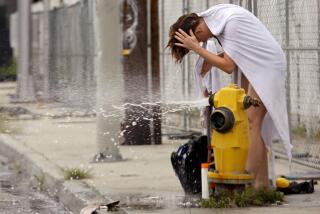This L.A. County program may have kept some at-risk youths out of legal trouble
Five years ago, Los Angeles County child welfare officials teamed up with criminal justice experts in the hope of stemming the flow of foster kids into the juvenile justice system.
They developed a risk assessment designed to spot youths in the child welfare system who were most likely to commit crimes and be arrested. Once a juvenile was identified as high risk, social workers and administrators with the Department of Children and Family Services were supposed to provide the youth extra counseling, mentoring and other services.
A new study by the National Council on Crime and Delinquency found that the effort, which ended in 2014, was inconsistently implemented, didn’t get enough resources and suffered from “drift” after structural and leadership changes within the child welfare agency.
See more of our top stories on Facebook >>
Not all kids designated high risk were provided the available services, the council report said, and often information about their cases was not tracked.
Still, researchers said the program showed promise. High-risk juveniles who received extra services had a lower arrest rate six months later compared with those who did not.
Among a group of children who didn’t get extra help, 9% were arrested within six months of being flagged as high risk. Seven percent were arrested in another group of youths, which included some members who received added services. In a third group, where the program was implemented more fully, none was arrested.
“Preventing crossover before it happens means substantial cost savings, but also brings incalculable benefits to children, families and communities,” said Kathy Park, chief executive of the crime and delinquency council, which developed the risk assessment.
Despite holes in the data and problems with the program’s implementation, Park said, the project “certainly demonstrates the significant potential that exists in using this type of approach.”
The county child welfare agency oversees about 35,000 children. Some are in foster care, and some, whose cases are monitored after a report of abuse or neglect, live at home.
Numerous studies have pointed to the link between child abuse and delinquent behavior later on. The county does not track how many youths cross over from the child welfare system to the juvenile justice system each year. But a recent study of outcomes for youths in the juvenile probation system found that about a fifth of them were involved in the county’s child welfare system at some point.
The program to flag high-risk youth was launched in late 2012 at Child and Family Services offices in Compton, Glendale, Palmdale and Lakewood.
The risk assessment tool relied on information about each juvenile that was entered by social workers into the agency’s case management system. The risk factors included the number of times a child’s family had been investigated on suspicion of abuse or neglect, histories of substance abuse or mental health issues and whether the youth was ever placed in a group home.
When a child was identified as high risk, the system automatically alerted case workers. At that point, officials were supposed to determine which extra services were needed and then track the child’s progress.
Researchers found, however, that the process was “not consistently implemented.” In part, they said, the issues stemmed from already overloaded social workers who had trouble getting the information they needed from schools and other outside agencies.
The report also found that in the spring of 2013, the child welfare agency “underwent significant organizational, structural, and staffing changes.” Researchers said the crossover prevention program’s transfer to a different bureau resulted in a period of “drift.”
The effort was briefly resurrected in 2014, with more thorough implementation and tracking, the report said. During that period, the program showed positive results.
Diane Iglesias, senior deputy director of children and family services, said Friday that the agency is interested in relaunching an expanded prevention program using the risk assessment tools of the previous effort.
But, she said, the department first would need to get information-sharing agreements in place with the probation department and other outside entities, train new social workers and possibly develop a “dedicated and targeted unit” to deal with high-risk juveniles.
“One of the most important things before considering it being department-wide is ensuring success,” Iglesias said.
Denise Herz, a criminal justice professor at Cal State L.A. who studies “crossover youth” and helped to develop the prevention project, said the county should incorporate the risk assessment tool into its regular programs and train social workers to identify the risk factors for delinquency.
“What L.A. did in terms of the tool and the programming has been watched across the nation,” she said.
Michael Nash, who formerly oversaw the Los Angeles juvenile court system and now heads the county’s new Office of Child Protection, said county officials should keep trying.
“The goal of the child welfare system is for children to grow up in safe, healthy, permanent, loving homes,” he said. “Anything short of that is essentially a failure. When youth … leave through the juvenile justice door, the system has failed one of its primary missions.”
Twitter: @sewella
ALSO
San Ysidro border crossing scheduled to get new pedestrian entrance
Manhunt continues for inmates as O.C. sheriff details elaborate escape
Santa Monica’s last unadulterated ‘shotgun’ house serves as a lesson in preservation
More to Read
Start your day right
Sign up for Essential California for news, features and recommendations from the L.A. Times and beyond in your inbox six days a week.
You may occasionally receive promotional content from the Los Angeles Times.







